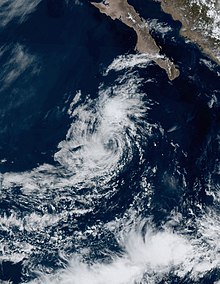Post-tropical cyclone
This article has multiple issues.Please helpimprove itor discuss these issues on thetalk page.(Learn how and when to remove these template messages)
|

Apost-tropical cycloneis a formertropical cyclonethat no longer possesses enough tropical qualities to be considered a tropical cyclone.[1]The word may refer to a former tropical cyclone undergoing extratropical transition or a tropical cyclone degenerating into a remnantlow.A tropical cyclone degenerating into atroughor wave, or having its low level circulation dissipate overland, lacks a cyclonic circulation and is referred as remnants instead of a post-tropical cyclone. However, post-tropical cyclones or remnants can continue producing high winds and heavy rains.[2]

Classification/Other post-tropical cyclones[edit]
Classes[edit]
Two classes of post-tropical cyclones exist
- Extratropical cyclone,which isfrontal,sometimes still retains winds ofhurricaneortropical stormforce.[1]Hurricane Paulette(2020) provides a recent example of an extratropical cyclone,[3]in which it no longer has a warm core in higher latitudes when it was overNova Scotiaand all points north in its trajectory.[4]
- Remnant low, which is non-frontal, has maximum sustained winds of less than 34 knots, and mainly consists of stablestratocumuluswith little to no convective activity. These shallow systems may meander for some time before opening into a trough of low pressure, or by being absorbed into an extratropical cyclone.[1][5][6]
Other post-tropical cyclones[edit]
Not all systems fall into the above two classes. According to the guideline, a system without frontal characteristics but with maximum winds above 34 knots may not be designated as a remnant low. It should be merely described as post-tropical.[7]A few examples falling into this grey area are listed below.
- Eugene(2011)[8]
- Michael(2012)[9]
- Nadine(2012)[10]
- Humberto(2013)[11]
- Joaquin(2015)[12]
- Matthew(2016)[13]
- Jerry(2019)[14]
- Paulette(2020)[15]
- Guambe(2021)
- Linda(2021)[16]
- Batsirai(2022)
- Emnati(2022)
- Blas(2022)[17]
- Frank(2022)[18]
- Howard(2022)[19]
- Kay(2022)[20]
However, there has been an occasion that theUnited StatesNational Hurricane Centerwent against that definition and designatedCalvin(2011) as a 35-knot remnant low.[21]
Also, if a tropical cyclone degenerates into atropical waveortrough,then it does not qualify as a post-tropical cyclone. It would be referred as the "remnants of (tropical cyclone name)".
Météo-Franceclassifies systems in the South-West Indian Ocean undergoing anextratropical transitionor losing tropical characteristics as "post-tropical depressions", since the2012–13 cyclone season.They would be re-classified as extratropical depressions after completing the process.[22]
Formation[edit]
A post-tropical cyclone is formed when the typical characteristics of atropical cycloneare replaced with those ofextratropical cyclones,otherwise known asextratropical transition.[23]After the initial formation, a post-tropical cyclone has the potential to gain strength and intensity by forming an extratropical storm.[23]If a post-tropical cyclone does become an extratropical storm, it will eventually decay through the process ofocclusion.[24]
Impacts[edit]
The re-intensification of a post-tropical cyclone can cause dangerous conditions in North Atlantic shipping routes with high seas and winds comparable to those ofhurricanes.[23]
Origin[edit]
The terminology was initiated by Meteorologist Peter Bowyer of theCanadian Hurricane Centrein 1998 duringTropical Storm Bonnie.[25]In 2008, the National Hurricane Center used this term forTropical Storm Laurato address the limitation of the two classes (extratropical/remnant low) mentioned above.[26]The term was later adopted by theNational Weather Serviceon May 15, 2010.[7]
Synonym[edit]
TheBureau of MeteorologyinAustraliarefers to a former tropical cyclone as an "ex-tropical cyclone".[27]An example isex-tropical cyclone Oswald.
See also[edit]
References[edit]
- ^abc"Glossary of NHC Terms".www.nhc.noaa.gov.
- ^"Glossary of NHC Terms".www.nhc.noaa.gov.Retrieved2021-01-25.
- ^"Post-Tropical Cyclone Dorian Forecast+Discussion".www.nhc.noaa.gov.Retrieved2019-09-07.
- ^"Dorian causing damage in Canada after losing 'hurricane' status".8 September 2019.
- ^Zelinsky, David A.; Pasch, Richard J. (2015-01-30).Hurricane Marie(PDF)(Report).Archived(PDF)from the original on 2022-12-17.
- ^"Post-Tropical Cyclone MARIE".www.nhc.noaa.gov.Retrieved2021-02-19.
- ^ab"SERVICE CHANGE NOTICE 10-06".Nws.noaa.gov.National Weather Service. January 15, 2010. Archived fromthe originalon October 30, 2012.Retrieved13 October2017.
- ^"Post-Tropical Cyclone EUGENE".National Hurricane Center.
- ^"Post-Tropical Cyclone MICHAEL".National Hurricane Center.
- ^"Post-Tropical Cyclone NADINE".National Hurricane Center.
- ^"Post-Tropical Cyclone HUMBERTO".www.nhc.noaa.gov.
- ^"Post-Tropical Cyclone JOAQUIN".National Hurricane Center.
- ^"Post-Tropical Cyclone MATTHEW".National Hurricane Center.Retrieved2016-10-09.
- ^"Post-Tropical Cyclone JERRY".National Hurricane Center.Retrieved2019-09-28.
- ^"Post-Tropical Cyclone PAULETTE".www.nhc.noaa.gov.Retrieved2022-11-16.
- ^"Post-Tropical Cyclone LINDA".www.nhc.noaa.gov.Retrieved2022-11-16.
- ^Reinhart, Brad (June 20, 2022).Post-Tropical Cyclone Blas Advisory Number 26(Report). Miami, Florida: National Hurricane Center.RetrievedJune 20,2022.
- ^"Post-Tropical Cyclone FRANK".www.nhc.noaa.gov.Retrieved2022-11-16.
- ^"Post-Tropical Cyclone HOWARD".www.nhc.noaa.gov.Retrieved2022-11-16.
- ^"Post-Tropical Cyclone KAY".www.nhc.noaa.gov.Retrieved2022-11-16.
- ^http://www.nhc.noaa.gov/data/tcr/EP032011_Calvin.pdf
- ^"Saison 2012-2013"(in French). Météo-France.Retrieved5 February2018.
- ^abcPelissero, Jonathon; Chiao, Sen (July 5, 2013)."The influences of post-tropical reintensification and dissipation on North Atlantic shipping routes".Meteorological Applications.21(3).Royal Meteorological Society:755.Bibcode:2014MeApp..21..755P.doi:10.1002/met.1410.
- ^"Extratropical Cyclone".britannica.com.Encyclopædia Britannica.RetrievedOctober 27,2016.
- ^"Learn about hurricanes: Post-tropical cyclones".16 June 2009.
- ^"Tropical Storm LAURA".www.nhc.noaa.gov.
- ^"Tropical Cyclone Outlook".Bureau of Meteorology.

